Where Is the Path to Sustainable Marine Development? Evaluation and Empirical Analysis of the Synergy between Marine Carrying Capacity and Marine Economy High-Quality Development
Abstract
1. Introduction
2. Research Design and Methodology
2.1. Research Design
2.2. Synergistic Relationship between Marine Carrying Capacity and Marine Economy High-Quality Development
2.3. Evaluation Indicator System
2.3.1. Selection Indicators of the Marine Carrying Capacity
2.3.2. Selection Indicators of Marine Economy High-Quality Development
2.4. Methods
2.4.1. Entropy-Weighted TOPSIS Method
2.4.2. Composite System Synergy Model
2.4.3. Geodetectors
3. Study Area and Data
3.1. Study Area
3.2. Index Weights
3.3. Data Source
4. Empirical Results
4.1. Characteristics of the Evolution of the Marine Carrying Capacity and Marine Economy High-Quality Development
4.1.1. Analysis of the Marine Carrying Capacity
4.1.2. Analysis of the Marine Economy Quality Development Index
4.2. Synergistic Analysis of the Marine Carrying Capacity and Marine Economy High-Quality Development
4.3. Analysis of Driving Factors
4.3.1. Selection of Driver Indicators
4.3.2. Analysis Based on Detection Factors
- (1)
- The level of marine consumption capacity (Z5), marine openness capacity (Z6), and marine industry structure level (Z2) belong to the same level, and the influence index is high. This indicates that the level of marine consumption capacity, the ability to open up to the outside world, and the level of marine industry structure have a high influence on the synergistic MCC and MEHD. China’s marine economy has a lot of room for external development, which can promote cooperation in knowledge, technology, experience, and talents, which, in turn, has an impact on the conversion of the MCC; the development of new marine industries driven by scientific and technological innovation enhances the conversion of the MCC and promotes industrial upgrading to realise the conversion of kinetic energy. In 2006–2020, for all three factors, the q-values are above 0.7, and the difference in each region result in differences in the influence of the q-value of each detection factor on synergy in different periods, while the influence the q-value fluctuates and changes the trend [49].
- (2)
- The impact of marine science and technology innovation capability (Z3) on synergy is at a medium level. The q-values of the number of invention patents owned by marine research institutions during the study period are 0.574, 0.654, 0.825, and 0.734, respectively. The increase in the number of invention patents owned by marine research institutions means that the level of marine science and technological innovation has been improved to a certain extent. The MEHD enhances the level of marine economic kinetic energy conversion. Under the strategy of innovation-driven development and science and technology for the sea, the coverage of marine science and technology innovation has gradually expanded, the fields involved have gradually become more extensive, and the momentum of the conversion of the kinetic energy of the marine economy is sufficient.
- (3)
- The impact of land-based economic development capacity (Z1) and marine economic development capacity (Z4) on synergy is at a relatively low level. Land-based economic development is an important factor influencing the MEHD, and to a large extent guides the development direction of the marine economy, which relies on the land-based economy for its development, so the future development of the marine economy should pay more attention to the synergistic development of the sea and land. With the deepening of the opening up and regional policies, regional development is gradually taking shape, and the link between land-based economic development supporting marine economic development is further strengthened.
4.3.3. Influence Factor Interaction Detection
5. Discussion
- (1)
- Academics pay more attention to theoretical research on the connotation and mechanism of the MCC and are limited to quantitative analysis and measurement in specific areas, and the research on the synergistic relationship between the MCC and MEHD is still relatively weak and lacks theoretical discussion and empirical analysis. This paper is based on the connotation and mechanism of China’s MCC. It explores the synergistic relationship, constructs a comprehensive evaluation index system, and analyses the main influence mechanisms of China’s marine economic development and the MCC in China and coastal areas by clarifying the evolution trends of the indexes, orderliness, and synergism of China’s MEHD and MCC, which will be useful for promoting the development of the marine economy and the MCC in accordance with local conditions. It can provide some ideas for promoting the development of the marine economy and the enhancement of the MCC according to local conditions.
- (2)
- The Fourteenth Five-Year Plan period is a critical period for the reshaping of the international economic order and the MEHD. Enhancing the MCC is of great significance in promoting the sustained and stable growth of the marine economy and realising the MEHD. At present, there is an urgent need to deepen the understanding of the connotation of the MCC and the research mechanism, accurately grasp the key difficulties and focuses of the development of the marine economy and the MCC, build a number of marine strategic emerging industries that are the leaders in enhancing the MCC, transform the old kinetic energies on the basis of sorting out the deficiencies in the development of the marine economy, and achieve the goal of optimising the layout of the industry through scientific and technological marine innovations, fostering new industries, transforming the development mode, and optimising the layout of the industry.
- (3)
- Due to the difficulty of obtaining marine data, the indicator system of the MCC index in this study still needs to be further improved, such as the institutional mechanism and the development mode, which can be further deepened in subsequent studies; this study only involves the national scale, and it is not yet possible to spatially analyse the various regions of China’s coasts, so future studies can explore the characteristics of the spatial evolution of the MCC at a more microscopic level. In addition, in terms of influencing factors, factors such as human capital level and government policy support have not yet been included. More in-depth research is needed on these aspects of China’s MCC and MEHD.
6. Conclusions
- (1)
- During the study period, China’s MCC index and the MEHD index both showed a growing trend, in which the marine environment carrying capacity was at a high level. There were fluctuating trends in the marine resource carrying capacity, the marine economy carrying capacity, the marine society carrying capacity, and the marine science and technology carrying capacity, which were basically the same and reflected, to a certain extent, that technology, industry, knowledge, and finance were the important factors influencing the enhancement of the MCC. The protection of marine ecology, the use of marine resources, and the management of pollution have yet to be strengthened, and it is necessary to continuously enhance the protection of marine ecology and the environment, reduce the discharge of industrial and domestic wastewater and solid waste, and improve the efficiency of the management of marine ecology and the environment.
- (2)
- The synergistic development relationship, along with the carrying capacity of the sea area and the marine economy quality development subsystem, shows a gradual upward trend, and the system composite index also shows a slow upward trend. The MCC and MEHD of the subsystem of the order of the overall trend of the rising. Degree of the order of the rising degree of the MEHD of the degree of order of the whole is higher than the MCC, resulting in the overall synergistic degree of the two being lower and a synergistic process of the existence of volatility.
- (3)
- Geodetector analysis found that the spatial differentiation of the synergistic influence factors of the MCC and the MEHD are mainly the level of marine consumption capacity, the capacity to open up to the outside world, and the level of the structures of the marine industry, and the interaction of the factors is mostly a two-factor enhancement relationship.
Author Contributions
Funding
Data Availability Statement
Conflicts of Interest
References
- Zhang, K.; Tian, S.-Z.; Wu, Y.; Wu, J.; Liu, N.; Wang, D. Evaluation of China’s maritime power construction index and policy textual analysis. Mar. Econ. Manag. 2023, 6, 2116–2150. [Google Scholar] [CrossRef]
- Zou, W.; Yang, Y.; Yang, M.; Zhang, X.; Lai, S.; Chen, H. Analyzing efficiency measurement and influencing factors of China’s marine green economy: Based on a two-stage network DEA mode. Front. Mar. Sci. 2023, 10, 1020373. [Google Scholar] [CrossRef]
- Barry, J.; Maxwell, D.; Jennings, S.; Walker, D.; Murray, J. Emon: An R-package to support the design of marine ecological and environmental studies, surveys and monitoring programmes. Methods Ecol. Evol. 2017, 8, 1342–1346. [Google Scholar] [CrossRef]
- Shao, W.; Xiong, Y.; Shi, D.; Xu, X.; Yue, W.; Soomro, M.A. Time dependent analysis of lateral bearing capacity of reinforced concrete piles combined with corrosion and scour. Ocean Eng. 2023, 282, 115065. [Google Scholar] [CrossRef]
- Casimiro, D.; Ventura, M.A.; Botelho, A.Z.; Guerreiro, J. Ecotourism in Marine Protected Areas as a tool to valuate natural capital and enhance good marine governance: A review. Front. Mar. Sci. 2023, 9, 1002677. [Google Scholar] [CrossRef]
- Xiao, J.; Hu, D. Construction and empirical study of the evaluation index system for high-quality development of marine economy in Guangdong Province based on five new development concepts. J. Phys. Conf. Ser. IOP Publ. 2020, 1629, 012030. [Google Scholar] [CrossRef]
- Di, Q.B.; Lv, D.H. Exploration of the relationship between the marine carrying capacity and the measurement of marine economic benefits and its response. Ecol. Econ. 2019, 35, 126–133+169. [Google Scholar]
- Han, L.M.; Luan, X.Z. A review of research on the marine carrying capacity. Mar. Dev. Manag. 2008, 25, 32–36. [Google Scholar]
- Kaeriyama, M.; Seo, H.; Kudo, H.; Nagata, M. Perspectives on wild and hatchery salmon interactions at sea, potential climate effects on Japanese chum salmon, and the need for sustainable salmon fishery management reform in Japan. Environ. Biol. Fish. 2012, 94, 165–177. [Google Scholar] [CrossRef]
- Chen, X.L.; Yu, Z.; Di, Q.B. Assessing the marine ecological welfare performance of coastal regions in China and analysing its determining factors. Ecol. Ind. 2023, 147, 109942. [Google Scholar] [CrossRef]
- Levrel, H.; Pioch, S.; Spieler, R. Compensatory mitigation in marine ecosystems: Which indicators for assessing the “no net loss” goal of ecosystem services and ecological functions? Mar. Policy 2012, 36, 1202–1210. [Google Scholar] [CrossRef]
- Li, W.; Yue, Q.; Hu, H.; Liu, L. Current status of ecological compensation for Bohai Sea reclamation and management countermeasures. Mar. Policy 2023, 155, 105778. [Google Scholar] [CrossRef]
- Alfosail, F.K.; Nayfeh, A.H.; Younis, M.I. A state space approach for the eigenvalue problem of marine risers. Meccanica 2018, 53, 747–757. [Google Scholar] [CrossRef]
- Bui, L.T.; Tran, D.L.T. Assessing marine environmental carrying capacity in semi-enclosed coastal areas—Models and related databases. Sci. Total Environ. 2022, 838, 156043. [Google Scholar] [CrossRef]
- Wang, L.; Kerr, L.A.; Record, N.R.; Bridger, E.; Tupper, B.; Mills, K.E.; Armstrong, E.M.; Pershing, A.J. Modeling marine pelagic fish species spatiotemporal distributions utilizing a maximum entropy approach. Fish. Oceanogr. 2018, 27, 571–586. [Google Scholar] [CrossRef]
- Sadiq, R.; Husain, T.; Veitch, B.; Bose, N. Risk-based decision-making for drilling waste discharges using a fuzzy synthetic evaluation technique. Ocean Eng. 2004, 31, 1929–1953. [Google Scholar] [CrossRef]
- Shao, W.; Sun, Q.; Xu, X.; Yue, W.; Shi, D. Durability life prediction and horizontal bearing characteristics of CFRP composite piles in marine environments. Constr. Build. Mater. 2023, 367, 130116. [Google Scholar] [CrossRef]
- Yu, Z.K.; Kong, H.Z. Evaluation of the rationality of spatial layout of marine fishery based on the marine carrying capacity: An example from the Blue Zone of Shandong Peninsula. Econ. Geogr. 2014, 34, 112–117. [Google Scholar]
- Shan, C.H.; Cui, S.S. Study on the development strategy selection of China’s coastal tourism under the perspective of marine carrying capacity. J. Ocean Univ. China (Soc. Sci. Ed.) 2016, 14–19. [Google Scholar] [CrossRef]
- Adams, C.M.; Hernandez, E.; Cato, J.C. The economic significance of the Gulf of Mexico related to population, income, employment, minerals, fisheries and ship. Ocean Coast. Manag. 2004, 47, 565–580. [Google Scholar] [CrossRef]
- Yu, Z.; Chen, X.L.; Di, Q.B. Integration of marine and terrestrial ecological economies in the cities of the Bohai rim, China, based on the concept of viscosity. Water 2023, 15, 749. [Google Scholar] [CrossRef]
- Chen, X.; Di, Q.; Hou, Z.; Yu, Z. Measurement of carbon emissions from marine fisheries and system dynamics simulation analysis: China’s northern marine economic zone case. Mar. Policy 2022, 145, 105279. [Google Scholar] [CrossRef]
- Bennett, N.J.; Dearden, P. From measuring outcomes to providing inputs: Governance, management, and local development for more effective marine protected areas. Mar. Policy 2014, 50, 96–110. [Google Scholar] [CrossRef]
- Nong, T.N.M. Performance efficiency assessment of Vietnamese ports: An application of Delphi with Kamet principles and DEA model. Asian J. Shipp. Logist. 2023, 39, 1–12. [Google Scholar] [CrossRef]
- Wang, S.; Lu, B.; Yin, K. Financial development, productivity, and high-quality development of the marine economy. Mar. Policy 2021, 130, 104553. [Google Scholar] [CrossRef]
- Chen, X.; Di, Q.; Jia, W.; Hou, Z. Spatial correlation network of pollution and carbon emission reductions coupled with high-quality economic development in three Chinese urban agglomerations. Sustain. Cities Soc. 2023, 94, 104552. [Google Scholar] [CrossRef]
- Chen, X.; Sun, Z.; Di, Q.; Liang, C. Marine fishery carbon emission reduction and changing factors behind marine fishery eco-efficiency growth in China. Ecol. Inform. 2024, 80, 102478. [Google Scholar] [CrossRef]
- Cavallo, M.; Bugeja Said, A.; Pérez Agúndez, J.A. Who is in and who is out in ocean economies development? Sustainability 2023, 15, 3253. [Google Scholar] [CrossRef]
- Wei, X.; Hu, Q.; Shen, W.; Ma, J. Influence of the evolution of marine industry structure on the green total factor productivity of marine economy. Water 2021, 13, 1108. [Google Scholar] [CrossRef]
- Blasiak, R.; Jouffray, J.B.; Amon, D.J.; Claudet, J.; Dunshirn, P.; Søgaard Jørgensen, P.; Pranindita, A.; Wabnitz, C.C.C.; Zhivkoplias, E.; Österblom, H. Making marine biotechnology work for people and nature. Nat. Ecol. Evol. 2023, 7, 482–485. [Google Scholar] [CrossRef]
- Zheng, J.H.; Di, Q.B. Coupling analysis of marine economic development level and sea-shore carrying capacity in Round-the-Bohai Region. Mar. Econ. 2017, 7, 37–46. [Google Scholar]
- Uddin, M.G.; Nash, S.; Rahman, A.; Dabrowski, T.; Olbert, A.I. Data-driven modelling for assessing trophic status in marine ecosystems using machine learning approaches. Environ. Res. 2023, 242, 117755. [Google Scholar] [CrossRef]
- Cheng, J.; Zhang, X.; Gao, Q. Analysis of the spatio-temporal changes and driving factors of the marine economic–ecological–social coupling coordination: A case study of 11 coastal regions in China. Ecol. Ind. 2023, 153, 110392. [Google Scholar] [CrossRef]
- Cao, Q.; Sun, C.; Zhao, L.; Cao, W.; Yan, X. Marine resource congestion in China: Identifying, measuring, and assessing its impact on sustainable development of the marine economy. PLoS ONE 2020, 15, e0227211. [Google Scholar] [CrossRef]
- Xin, Z. Study on the evaluation of the carrying capacity of marine resources and Environment in Weihai City in China. Popul. Res. Environ. Econ. 2023, 4, 1–14. [Google Scholar]
- Ma, R.; Ji, S.; Ma, J.; Shao, Z.; Zhu, B.; Ren, L.; Li, J.; Liu, L. Exploring resource and environmental carrying capacity and suitability for use in marine spatial planning: A case study of Wenzhou, China. Ocean Coast. Manag. 2022, 226, 106258. [Google Scholar] [CrossRef]
- Gao, J.; An, T.; Shen, J.; Zhang, K.; Yin, Y.; Zhao, R.; He, G.; Hynes, S.; Jattak, Z.U. Development of a land-sea coordination degree index for coastal regions of China. Ocean Coast. Manag. 2022, 230, 106370. [Google Scholar] [CrossRef]
- Oldenburg, M.; Jensen, H.J. Maritime welfare facilities—Utilization and relevance for the compensation of shipboard stress. J. Occup. Med. Toxicol. 2019, 14, 11. [Google Scholar] [CrossRef]
- Sedghiyan, D.; Ashouri, A.; Maftouni, N.; Xiong, Q.; Rezaee, E.; Sadeghi, S. RETRACTED: Prioritization of renewable energy resources in five climate zones in Iran using AHP, hybrid AHP-TOPSIS and AHP-SAW methods. Sustain. Energy Technol. Assess. 2021, 44, 101045. [Google Scholar] [CrossRef]
- Wang, S.; Chen, S.; Zhang, H.; Song, M. The model of early warning for China’s marine ecology-economy symbiosis security. Mar. Policy 2021, 128, 104476. [Google Scholar] [CrossRef]
- Possamai, B.; Vollrath, S.R.; Vieira, J.P.; Garcia, A.M. Synergistic climatic and anthropogenic effects on marine species turnover in estuarine waters. Sci. Total Environ. 2024, 908, 168324. [Google Scholar] [CrossRef]
- Kosmopoulos, J.C.; Campbell, D.E.; Whitaker, R.J.; Wilbanks, E.G. Horizontal gene transfer and CRISPR targeting drive phage-bacterial host interactions and co-evolution in pink berry marine microbial aggregates. bioRxiv 2023, 2. [Google Scholar] [CrossRef]
- Hao, Y.; Sun, C.; Wei, J.; Gu, S. Study on measuring and evaluating the synergy effect of regional coal mine emergency management in China based on the composite system synergy model. Geofluids 2022, 2022, 1845795. [Google Scholar] [CrossRef]
- Sun, Z.; Guan, H.; Zhao, A. Research on the synergistic effect of the composite system for high-quality development of the marine economy in China. Systems 2023, 11, 282. [Google Scholar] [CrossRef]
- Wang, J.F.; Xu, C.D. Geodetector: Principles and Prospects. Acta Geogr. Sin. 2017, 72, 116–134. [Google Scholar]
- Glein, C.R.; Shock, E.L. Sodium chloride as a geophysical probe of a subsurface ocean on Enceladus. Geophys. Res. Lett. 2010, 37. [Google Scholar] [CrossRef]
- Zhang, C.; Wang, M. Assessing the conjugal of the marine economy-ecology-society composite system: China’s Case. Front. Mar. Sci. 2022, 9, 963468. [Google Scholar] [CrossRef]
- Lin, Y.; Yang, Y.; Li, P.; Feng, C.; Ding, J.; Zhou, J.; Jiang, Q.; Ye, G. Spatial-temporal evaluation of marine ecological civilization of Zhejiang province, China. Mar. Policy 2022, 135, 104835. [Google Scholar] [CrossRef]
- Lv, P.; Li, X.; Zhang, H.; Liu, X.; Kong, L. Research on the spatial and temporal distribution of logistics enterprises in Xinjiang and the influencing factors based on POI data. Sustainability 2022, 14, 14845. [Google Scholar] [CrossRef]
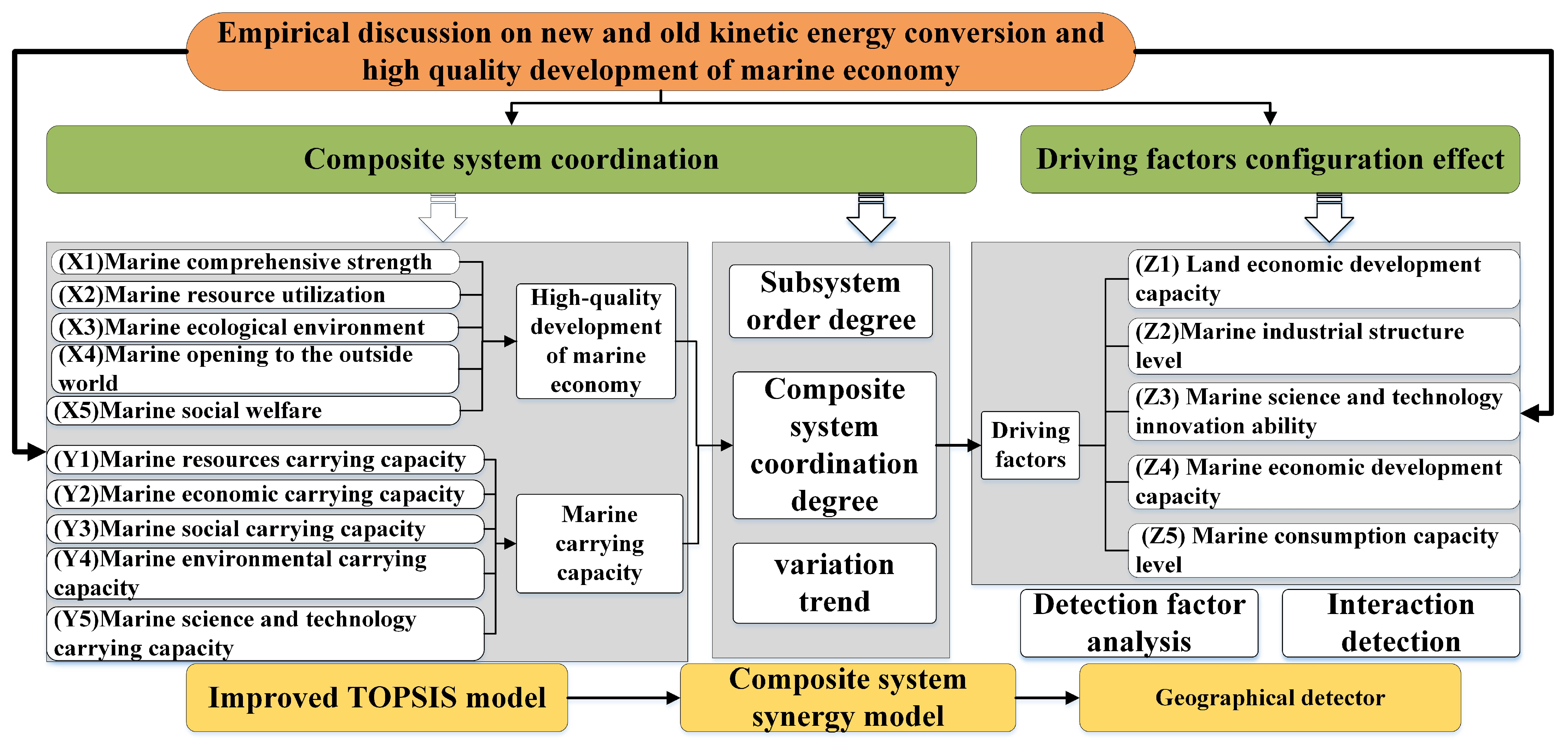
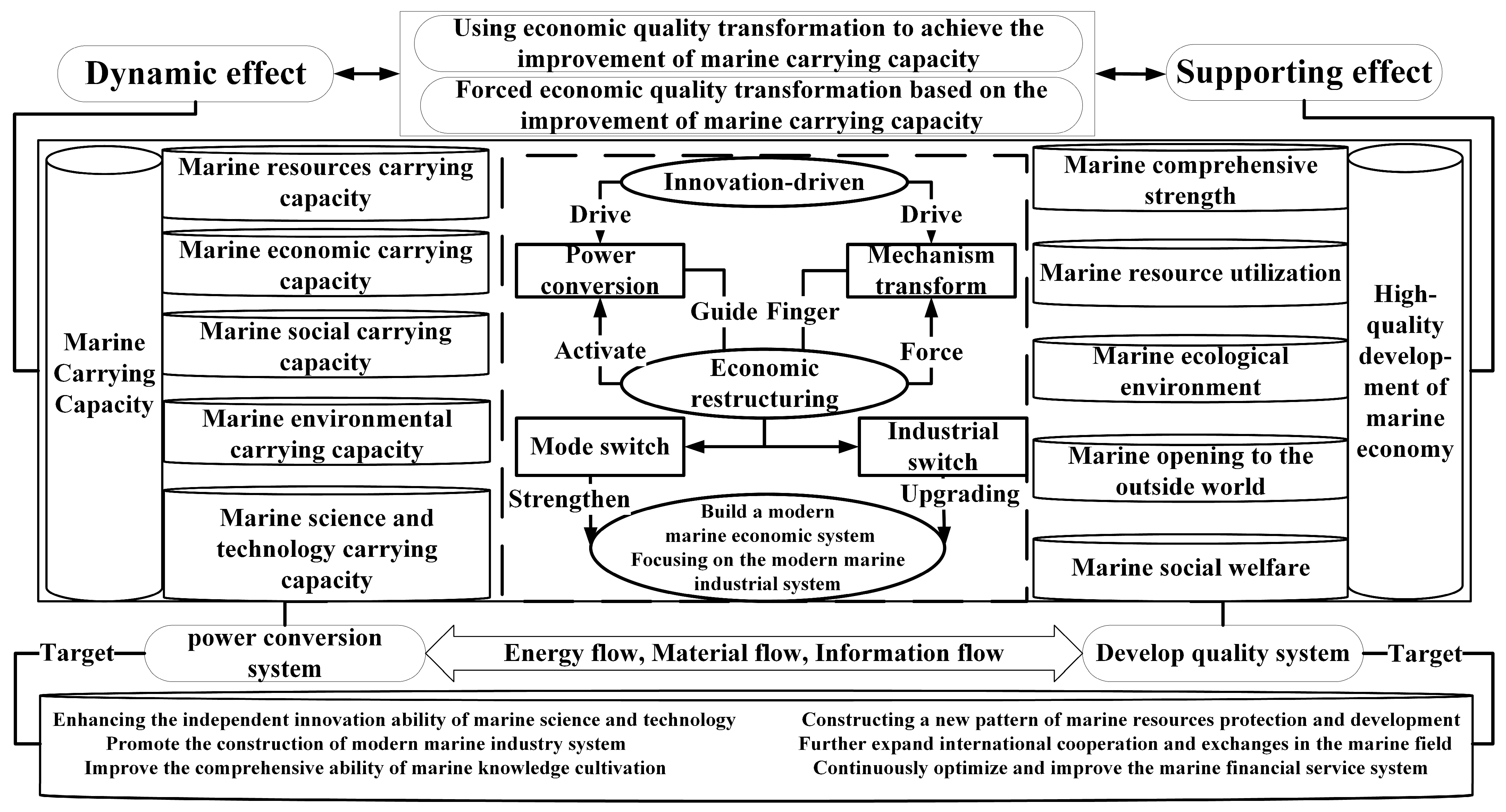
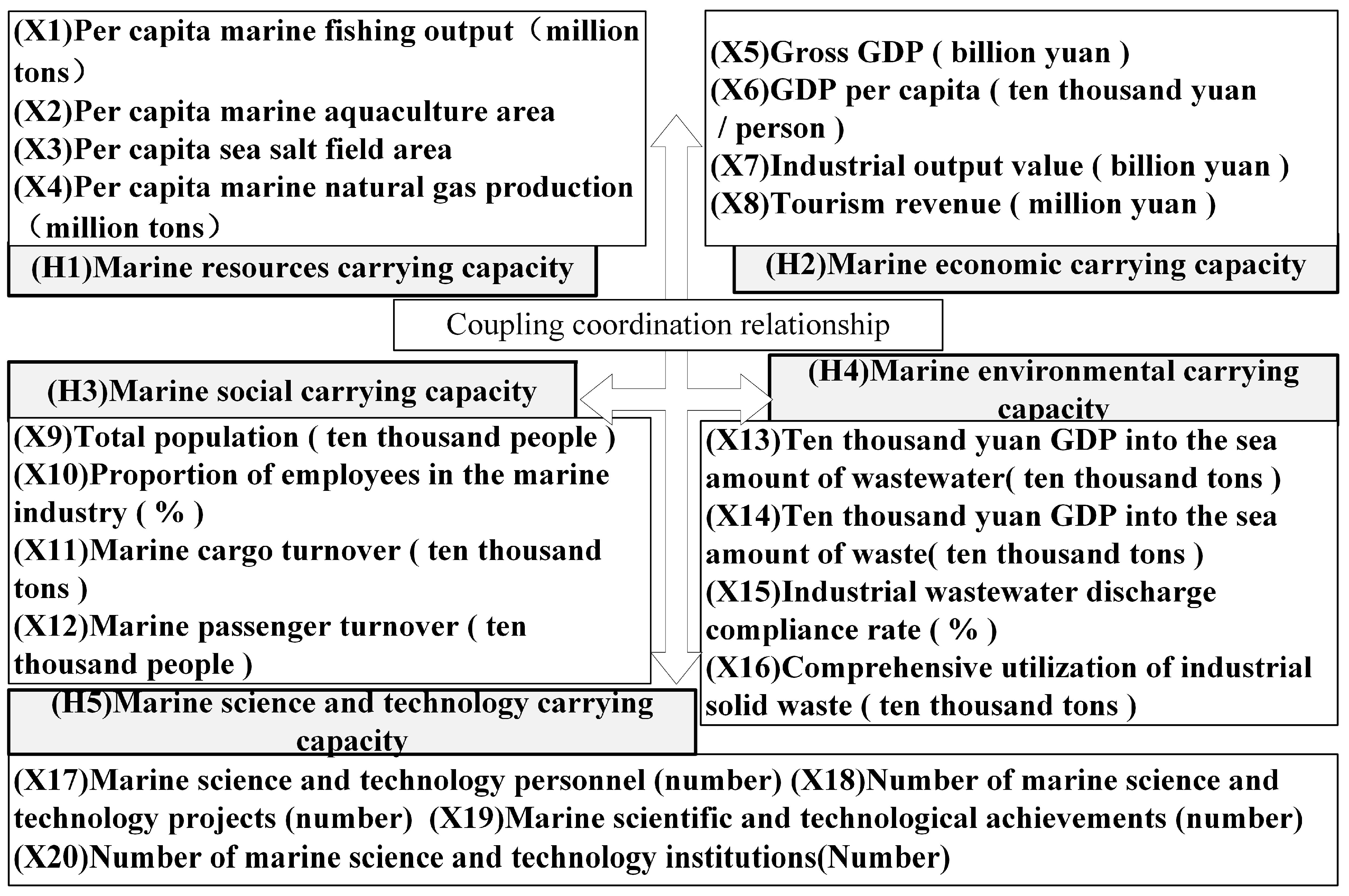
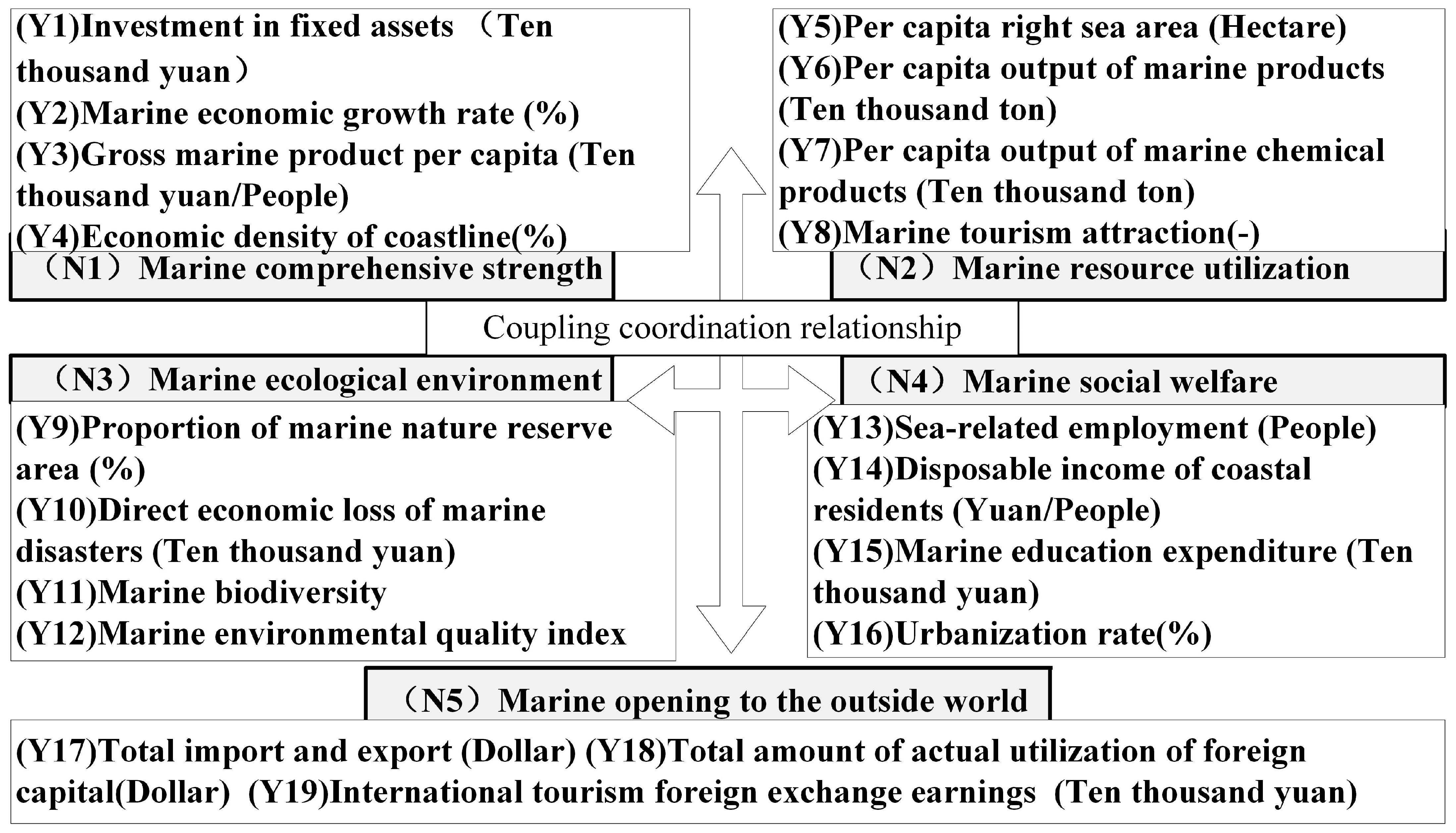


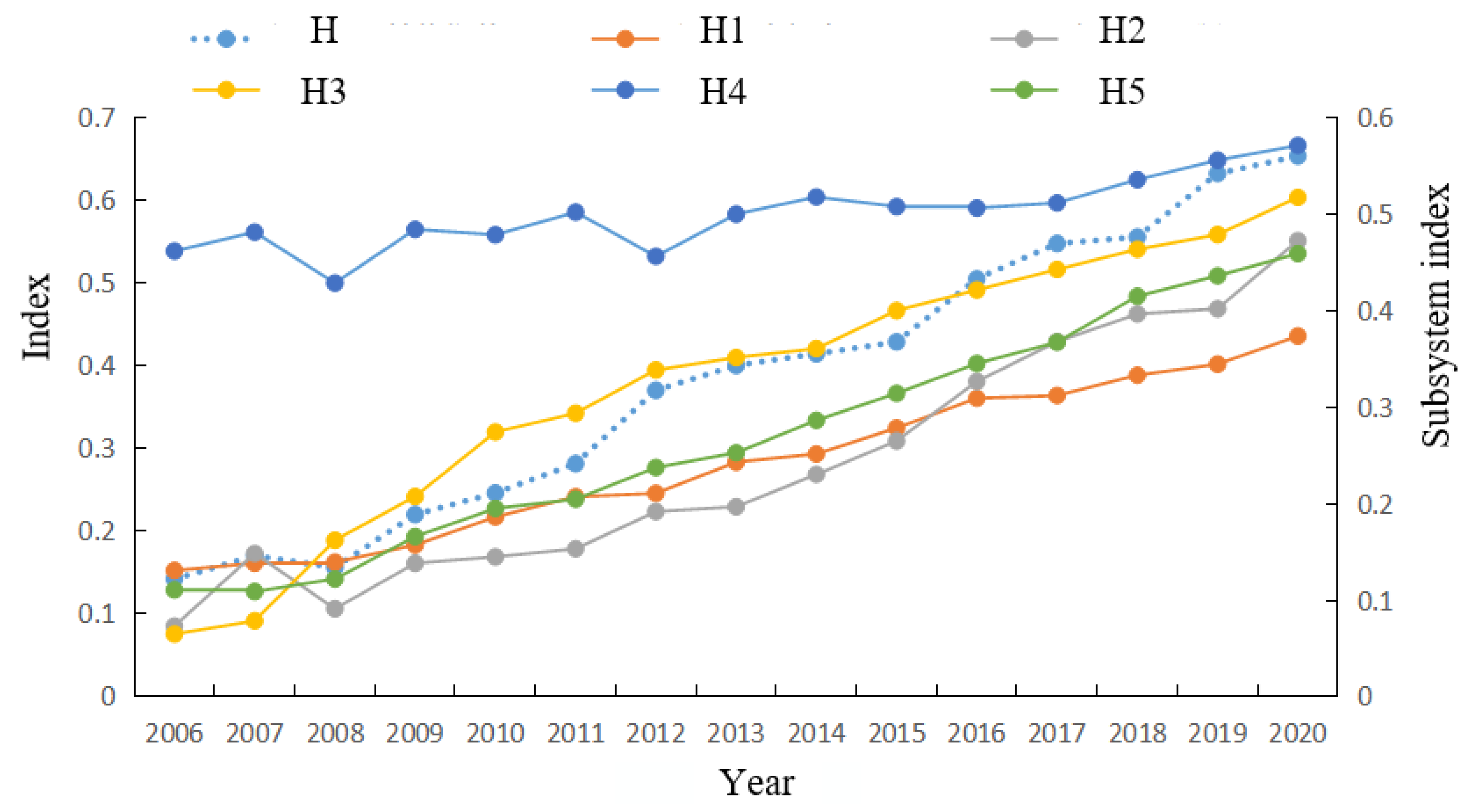
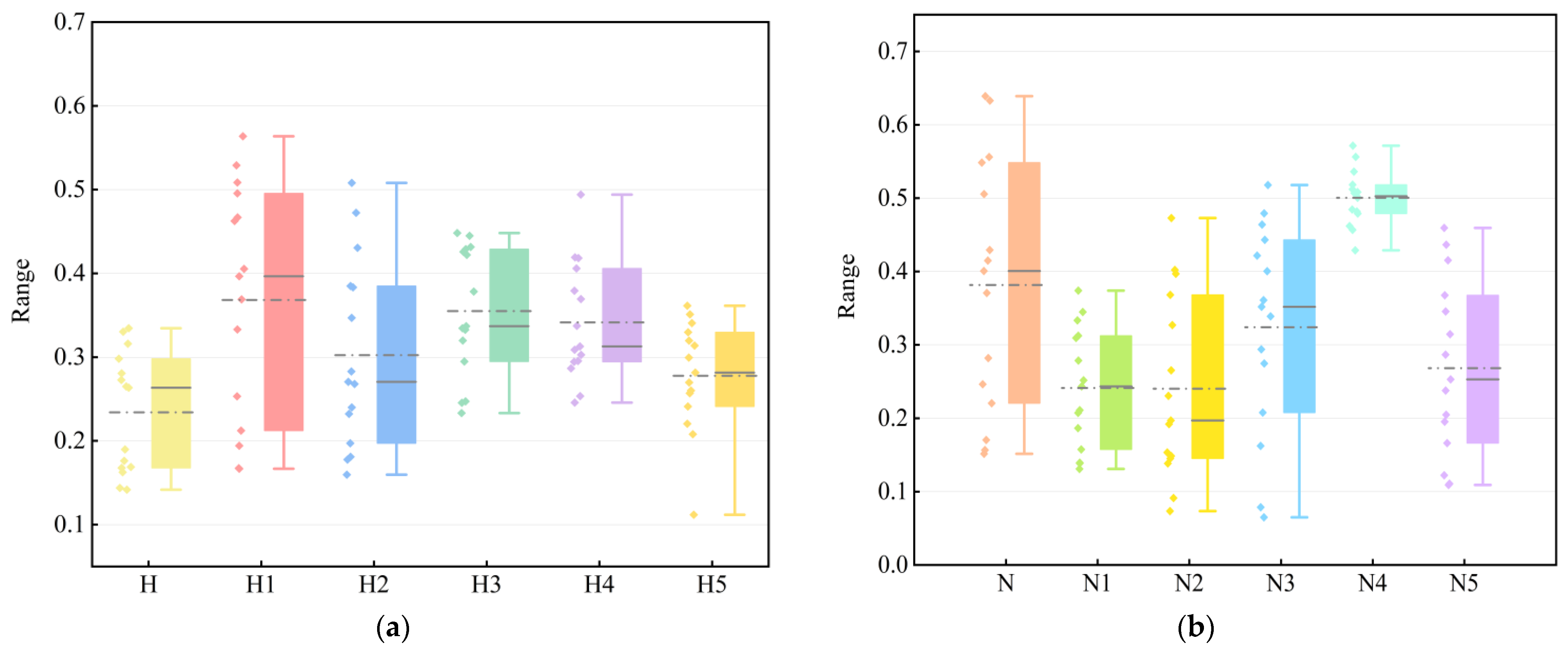

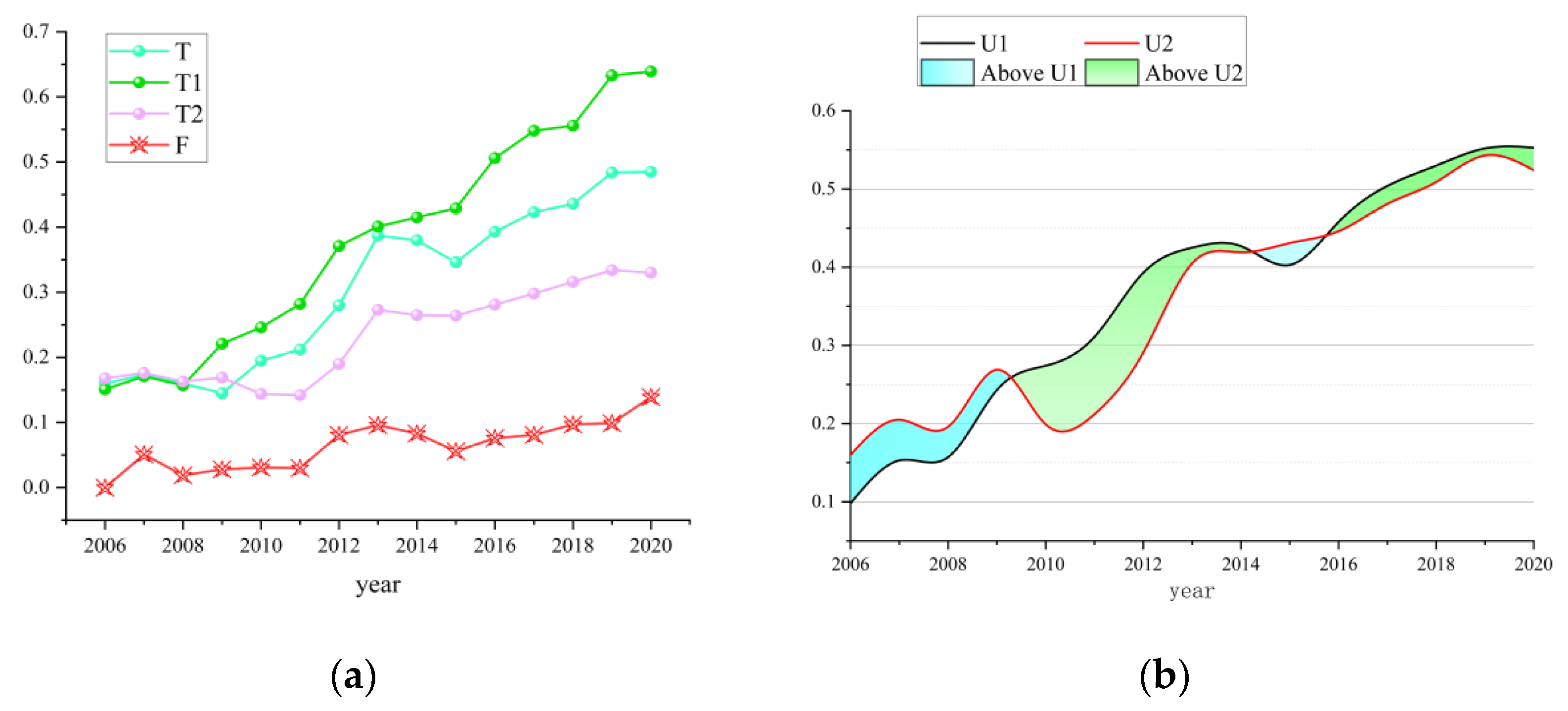
| Synergy Degree | [−1, −0.6] | (−0.6, −0.2] | (−0.2, 0] | (0, 0.2] | (0.2, −0.6] | (0.6, −1] |
| Collaborative state | Highly non-synergy | Moderate non-synergy | Mild non-synergy | Mild synergy | Moderate synergy | Highly synergy |
| Year | System Comprehensive Development Index (T) | Marine Carrying Capacity (N) | High-Quality Development Index (H) | Order Degree of Marine Carrying Capacity Subsystem (U1) | Order Degree of High-Quality Development Subsystem (U2) | Composite System Coordination Degree (F) | Standards |
|---|---|---|---|---|---|---|---|
| 2006 | 0.160 | 0.151 | 0.168 | 0.098 | 0.160 | - | - |
| 2007 | 0.173 | 0.171 | 0.176 | 0.153 | 0.205 | 0.156 | Mild non-synergy |
| 2008 | 0.160 | 0.157 | 0.163 | 0.157 | 0.196 | 0.191 | Mild non-synergy |
| 2009 | 0.145 | 0.221 | 0.169 | 0.243 | 0.269 | 0.281 | Mild synergy |
| 2010 | 0.195 | 0.246 | 0.144 | 0.274 | 0.199 | 0.309 | Mild synergy |
| 2011 | 0.212 | 0.282 | 0.142 | 0.311 | 0.212 | 0.304 | Mild synergy |
| 2012 | 0.280 | 0.371 | 0.190 | 0.393 | 0.291 | 0.281 | Mild synergy |
| 2013 | 0.387 | 0.401 | 0.273 | 0.425 | 0.405 | 0.296 | Mild synergy |
| 2014 | 0.380 | 0.415 | 0.265 | 0.427 | 0.419 | 0.383 | Mild synergy |
| 2015 | 0.346 | 0.429 | 0.264 | 0.403 | 0.431 | 0.356 | Mild synergy |
| 2016 | 0.393 | 0.506 | 0.281 | 0.458 | 0.446 | 0.376 | Mild synergy |
| 2017 | 0.423 | 0.548 | 0.298 | 0.504 | 0.481 | 0.381 | Mild synergy |
| 2018 | 0.436 | 0.556 | 0.316 | 0.530 | 0.509 | 0.397 | Mild synergy |
| 2019 | 0.484 | 0.633 | 0.334 | 0.552 | 0.543 | 0.409 | Moderate synergy |
| 2020 | 0.485 | 0.639 | 0.330 | 0.553 | 0.524 | 0.339 | Mild synergy |
| Level Measurement of Factor | 2006 | 2010 | 2015 | 2020 |
|---|---|---|---|---|
| (Z1) Land economic development capacity | 0.338 | 0.459 | 0.564 | 0.688 |
| (Z2) Marine industrial structure level | 0.864 | 0.746 | 0.920 | 0.763 |
| (Z3) Marine science and technology innovation | 0.574 | 0.654 | 0.825 | 0.734 |
| (Z4) Marine economic development capacity | 0.426 | 0.528 | 0.747 | 0.573 |
| (Z5) Marine consumption capacity level | 0.831 | 0.857 | 0.842 | 0.652 |
| (Z6) Marine opening capacity level | 0.711 | 0.743 | 0.768 | 0.663 |
| Year | Z1∩Z2 | Z1∩Z3 | Z1∩Z4 | Z1∩Z5 | Z1∩Z6 | Z2∩Z3 | Z2∩Z4 | Z2∩Z5 | Z2∩Z6 | Z3∩Z4 | Z3∩Z5 | Z3∩Z6 | Z4∩Z5 | Z4∩Z6 | Z5∩Z6 |
|---|---|---|---|---|---|---|---|---|---|---|---|---|---|---|---|
| 2006 | BE | NE | NE | BE | NE | BE | BE | BE | BE | NE | NE | NE | BE | BE | BE |
| 2010 | BE | NE | BE | BE | NE | NE | BE | BE | BE | NE | BE | BE | BE | BE | BE |
| 2015 | BE | BE | NE | BE | NE | BE | BE | BE | BE | BE | BE | BE | BE | NE | BE |
| 2020 | BE | BE | NE | BE | NE | BE | BE | NE | BE | NE | BE | NE | NE | NE | BE |
Disclaimer/Publisher’s Note: The statements, opinions and data contained in all publications are solely those of the individual author(s) and contributor(s) and not of MDPI and/or the editor(s). MDPI and/or the editor(s) disclaim responsibility for any injury to people or property resulting from any ideas, methods, instructions or products referred to in the content. |
© 2024 by the authors. Licensee MDPI, Basel, Switzerland. This article is an open access article distributed under the terms and conditions of the Creative Commons Attribution (CC BY) license (https://creativecommons.org/licenses/by/4.0/).
Share and Cite
Chen, X.; Yu, Z.; Liang, C.; Di, Q. Where Is the Path to Sustainable Marine Development? Evaluation and Empirical Analysis of the Synergy between Marine Carrying Capacity and Marine Economy High-Quality Development. Water 2024, 16, 394. https://doi.org/10.3390/w16030394
Chen X, Yu Z, Liang C, Di Q. Where Is the Path to Sustainable Marine Development? Evaluation and Empirical Analysis of the Synergy between Marine Carrying Capacity and Marine Economy High-Quality Development. Water. 2024; 16(3):394. https://doi.org/10.3390/w16030394
Chicago/Turabian StyleChen, Xiaolong, Zhe Yu, Chenlu Liang, and Qianbin Di. 2024. "Where Is the Path to Sustainable Marine Development? Evaluation and Empirical Analysis of the Synergy between Marine Carrying Capacity and Marine Economy High-Quality Development" Water 16, no. 3: 394. https://doi.org/10.3390/w16030394
APA StyleChen, X., Yu, Z., Liang, C., & Di, Q. (2024). Where Is the Path to Sustainable Marine Development? Evaluation and Empirical Analysis of the Synergy between Marine Carrying Capacity and Marine Economy High-Quality Development. Water, 16(3), 394. https://doi.org/10.3390/w16030394






